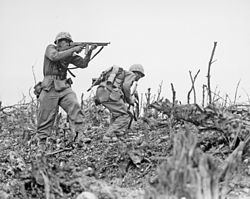Period January 1945 – June 1945 | Result Allied victory | |
 | ||
27,113 dead or missing,74,501 wounded,79 ships sunk and scrapped,773 aircraft destroyed 98,811-128,375 dead or missing,17,000 wounded,7,216 captured,21 ships sunk and scrapped,3,130 aircraft destroyed,75,000-140,000 civilians dead or missing Similar World War II, Pacific War, Attack on Yokosuka, Operation Tiderace, Battle of Mutanchiang | ||
The Volcano and Ryūkyū Islands campaign was a series of battles and engagements between Allied forces and Imperial Japanese forces in the Pacific Ocean campaign of World War II between January and June, 1945.
The campaign took place in the Volcano and Ryukyu island groups. The two main land battles in the campaign were the Battle of Iwo Jima (February 16-March 26, 1945) and the Battle of Okinawa (April 1-June 21, 1945). One major naval battle occurred, called Operation Ten-Go (April 7, 1945) after the operational title given to it by the Japanese.
The campaign was part of the Allied Japan campaign intended to provide staging areas for an invasion of Japan as well as supporting aerial bombardment and a naval blockade of the Japanese mainland. The dropping of atomic weapons on two Japanese cities and the hammer-blow Soviet invasion of Japanese Manchuria, however, caused the Japanese government to surrender without an armed invasion being necessary.
Campaign
Iwo Jima and Okinawa were two important islands, as they were right at Japan's doorstep, and could provide bases for B-29 bombers to raid the Japanese mainland. The operation to take Iwo Jima was authorized in October 1944. On February 19, 1945, the campaign for Iwo Jima was launched. The island was secure by March 26. Only a few Japanese were captured, as the rest were killed or committed suicide as defeat befell them. However, the Americans suffered a heavy toll in casualties in their initial landing, as opposed to the main fighting. Fighters began operations from March 11, when the airfields were secured, and the first bombers hit the home islands. Meanwhile, on Okinawa 131,000 Japanese soldiers dug in for similar resistance as compared to Iwo Jima, trying to mow down the Americans as they disembarked from their landing vehicles. Gen. Mitsuru Ushijima made sure that the Americans would not even come close to the beaches, using kamikazes under Soemu Toyoda to stem the tide. This was the greatest effort by the suicide bombers of legend, sinking 34 ships, damaging 25 beyond economic repair, and 343 were damaged to varying degrees. On the land campaign, 48,193 military personnel were killed, wounded, or missing in the campaign to secure the island. By the end of the battle, three-quarters of the Japanese officers were killed or had killed themselves. Only a handful of officers survived the battle, although more soldiers capitulated. On April 7, the great Japanese battleship Yamato was commissioned and sent out to use a kamikaze method, codenamed Ten-Go, but was sunk. The Vice-Admiral Seiichi Ito and the commander of the battleship, Kosaku Aruga, were killed in the fatal mission, and the battleship was destroyed before it could engage the US navy. Control of the Volcano and Ryukyu Islands enabled the US Army Air Forces to conduct missions against targets on Honshu and Kyushu, with the first raid occurring on Tokyo, from March 9–10.
